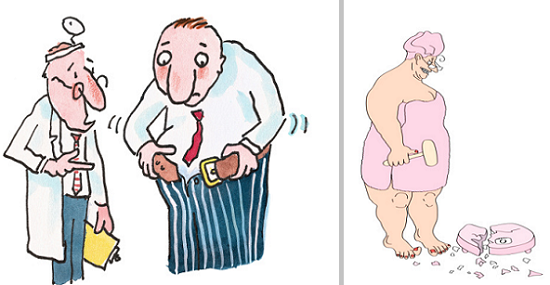Oct 16, 2025
Oct 16, 2025

The term "obesity" is derived from (Latin obesus from past participle "obedere", to eat away). Simply speaking obesity is a condition in which the body weight is increased due to excessive accumulation of fat. The fat is mainly deposited in the subcutaneous tissue (under the skin specially over the abdomen), and around such organs as the liver and heart. It is usually due to the caloric-intake being in excess of the body needs, combined with overeating and insufficient exercise. Other causes include various types of hormonal imbalances which require medical management.
Magnitude of the problem
The Times of India of 3rd November, 2012 carried an alarming news titled, "Every 3rd Indian battles the bulge". A new 11-city survey across the country showed that 36% of the people surveyed were above the 'ideal' weight (almost one in three citizens exceeded their ideal weight). Obesity is rapidly approaching epidemic proportions. About 23% of the people classified as healthy were on the verge of turning overweight, with their body mass index (BMI) soon crossing 22.9 level. The leading causes found were:(i) Eating oily/fatty food; (ii) Irregular eating habits; and (iii) Lack of physical activity. Another operative factor is the eating-out culture. The report also has a healthier side in that 15-19 age group recorded an overall obesity level of just 13 percent.
Criteria for grading obesity
1. Body Mass Index (BMI): Ideal weight for height is expressed as:
BMI =Body Weight in Kg divided by the height is Square meters.
The values are graded as under:
Below 18.5 — Underweight
18.5 to 24.9 — Normal 'ideal'
25.0 to 29.9 — Overweight
30.0 to 39.9 — Obese
Over 40 — Extremely Obese
The BMI is a reliable index for management of obesity.
2. Other Measures
(i) Based on height. Healthy weight for WOMEN is about 100 pounds (2.2 lbs + 1 Kg) for the first 5 feet, plus 5 lbs for each additional inch. Healthy weight for MEN is 106 lbs for the first 5 feet, plus 6 lbs for each additional inch.
(ii) Based on Waist Circumference. Risk of obesity related disease rises as under:
Moderate Risk:
MEN — equal to or greater than 94 Cm.
WOMEN — equal to or greater than 80 Cm.
High Risk:
MEN — equal to or greater than 102 Cm.
WOMEN — equal to or greater than 99 Cm.
(Ref: Your Health (IMA), pp 6-9, 12, July 2008)
(iii) Ideal Weight/Height Tables are also available for reference.
Obesity can lead to several disorders like --- Diabetes mellitus, Hypertension, Coronary artery disease, Stroke, Snoring, Piles, Muscle pain, Gout, Osteoarthritis, Gall bladder disorders, and Hyperlipidaemia (raised blood cholesterol levels).
Fast Food (Junk Food): Most fast foods are deep fried, with a high trans fat content. Dependence-producing liability has also been reported. They also have chemicals and additives to enhance the taste which on a long-term basis are likely to produce ill effects. A USA-UK study has reported that junk food is inducing 'puberty' in girls at an average age of 6 years. Boys also reached physical maturity up to 2 years earlier than in the past, i.e., by 9 or 10 years (TOI, 3rd November, 2012). This in all likelihood is related to the consumption of fast food.
Management of Obesity
Obesity is a lifestyle disease, and a change for the better is the only treatment.
The main factors involved are: Exercise, Food intake, and Food habits, which have to be changed accordingly. The use of appetite-suppressants (anorexiants drugs) to suppress hunger is an ineffective measure. Their chronic use can lead to serious alteration in the physiology of the individual.
Water: It is an essential component of our body, and almost 85% of our body is water. Dehydration (lack of body water) can cause a number of diseases including obesity (Chopra HK, "Lifestyle and Health" Sterling Paperback, 2006).
Stress: It has a definite role to play. It can lead to compulsive eating (bulimia) as a result of increased hunger.
Further the following measures can be adopted to control weight:
1. Exercise: Performingregular exercise strengthens the heart, lungs, and the bones. It also reduces stress, anxiety, and depression.
2. Alcohol & Smoking: They must be avoided, as they are dependence-producing, and damage several body organs.
3. Food and Food Habits: Irregular food habits are a cause for obesity. Food items which help in weight control:
- Whole grain (Bran).
- Eggs.
- Beans:They contain the enzyme cholecystokinin which helps in digestion, and fiber which suppresses hunger.
- Salads.
- Green tea: Green tea contains more flavonoids called 'catechins' (which are absent in black tea) help in weight control.
- Dairy Foods.
- PUFAs and MUFAs.
- Miscellaneous: Honey and Cocoa, Fibre, Vitamin C, Red capsicum, Sea food (Tuna & Sardines) are among other foodstuffs which help in weight control (Reader's Digest, Nov., 2012).
All said and done what is most important is to havethe will and wish to lose weight. Otherwise it may remain an exercise in futility.
05-Dec-2012
More by : Dr. Frank S. K. Barar